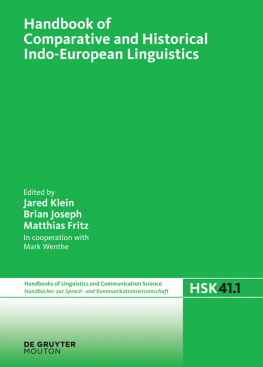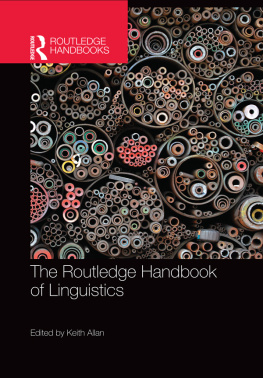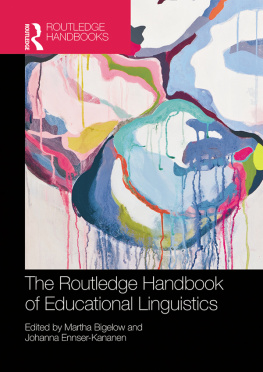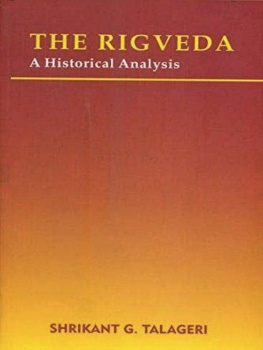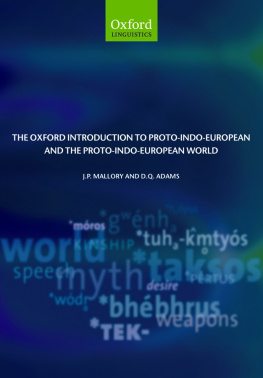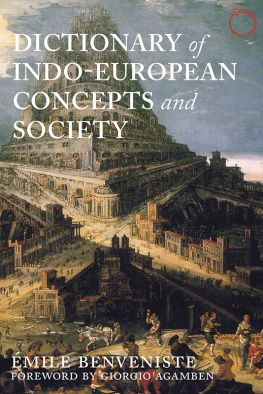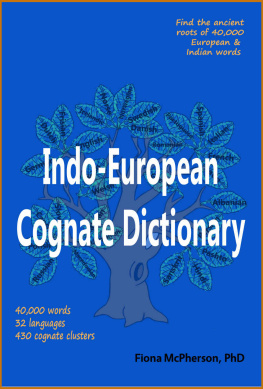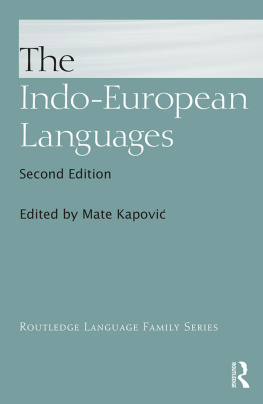Contents
Guide

Handbook of Comparative and
Historical Indo-European Linguistics
HSK 41.1
Handbcher zur
Sprach- und Kommunikationswissenschaft
Handbooks of Linguistics
and Communication Science
Manuels de linguistique et
des sciences de communication
Mitbegrndet von Gerold Ungeheuer
Mitherausgegeben (19852001) von Hugo Steger
Herausgegeben von / Edited by / Edits par
Herbert Ernst Wiegand
Band 41.1
De Gruyter Mouton

ISBN 978-3-11-018614-7
e-ISBN (PDF) 978-3-11-026128-8
e-ISBN (EPUB) 978-3-11-039324-8
ISSN 1861-5090
Library of Congress Cataloging-in-Publication Data
A CIP catalog record for this book has been applied for at the Library of Congress.
Bibliographic information published by the Deutsche Nationalbibliothek
The Deutsche Nationalbibliothek lists this publication in the Deutsche Nationalbibliografie; detailed bibliographic data are available on the Internet at http://dnb.dnb.de.
2017 Walter de Gruyter GmbH, Berlin/Boston
www.degruyter.com
Preface
In my graduate school days at Yale in the early 1970s, I dreamed of being part of a team that would produce an update and enlargement of Brugmanns Grundriss , in which the individual living branches of Indo-European would be traced from their roots to the modern day. As the years went by, this seemed increasingly to be no more than an idle fantasy. Then in the summer of 2004, I received an email message from Matthias Fritz (engineered by Stephanie Jamison) asking me whether I would be interested in participating in his proposed De Gruyter Handbook of Comparative and Historical Indo-European Linguistics (not precisely the original title). I asked him what the book entailed, and he told me that there would be sections on every subgroup of Indo-European, including chapters on phonology, morphology, syntax, and lexicon. Seeing an unexpected opportunity to fulfill my youthful dream, I said that I would participate, provided that three additional chapters would be added in each case: on documentation, dialectology, and, for those subgroups that had an ulterior history (i.e. everything but Anatolian and Tocharian), on evolution. A chapter on dialectology of course needs no special defense, but one on documentation has become something of an obsession of mine. It is of course not terribly critical for Greek, but for every other subgroup (including Italic, as soon as one moves beyond Latin), the reader needs to know what the primary sources are and how to find them. Thus, those looking for somebody to blame for the long gestation period of this book should probably focus their wrath on me for having added 34 chapters (27.2 %) to the book in one fell swoop.
Things did not, however, progress smoothly. I, for one, had at that point never engaged in editorial work and had no idea how to proceed; nor was it clear to me what my role was to be in the project. Years went by as the individual chapters of the book piled up in my office. In 2011, I received a notice from one of the authors saying that he wished to withdraw his contribution in order to publish it elsewhere. I saw then immediately that the entire project was about to unravel and proceeded to resign from my position. Very quickly I was contacted by Uri Tadmor of De Gruyter and urged not to resign; I was told that Brian Joseph would be brought on to assist me. By that time, I had indeed gained experience in editing; but it was not until June 30, 2012 that I seriously sat down to set things in motion for the production of this book. Ultimately, I was able to convince De Gruyter that I needed an additional in-house assistant, and Mark Wenthe, despite his very heavy teaching schedule, kindly agreed to assume this role.
From the date just noted, I have put this project at the highest level of priority, working at it consistently and placing all my other long-term research projects on hold. Some chapters were dropped, original submissions in three instances had to be redone by others. The result, I would like to believe, is the most significant presentation of the field of Indo-European Linguistics since the second edition of Brugmanns Grundriss , which appeared just over 100 years ago. The two works, however, have almost nothing in common. Brugmanns book was deductive, starting with Proto-Indo-European and deriving the phonologies and morphologies of the individual Indo-European languages. This work is inductive, beginning with the oldest attested subgroups and working toward the most recent ones, from there moving on to languages of fragmentary attestation, larger subgroups (Indo-Iranian and Balto-Slavic), wider configurations and contacts (Italo-Celtic, Greco-Anatolian relationships), and, ultimately, Proto-Indo-European and beyond. All of this is preceded by sections on general methodological issues, the use of the comparative method in selected language groups outside of Indo-European, and on the history, both remote and more recent, of the Indo-European question. Many may wonder about the need for the discussions of language families other than Indo-European, but the original title of this book, since changed, included the phrase An International Handbook of Language Comparison. While limitations of space forbid anything beyond a cursory glance outside Indo-European, these chapters will at the very least give the reader an overview of some of the most important literature on the language groups they cover.
It gives me great pleasure to acknowledge the cooperation and assistance of many others in the preparation of this book. First and foremost, kudos goes to Matthias Fritz for having conceptualized this project ex nihilo and having recruited the vast majority of its authors. To my two active collaborators, co-editor Brian Joseph and editorial assistant Mark Wenthe I would like to express my deepest appreciation. Both of them read and commented upon every paper and thereby insured that each chapter was seen by three pairs of eyes in addition to those of the author. To my former M.A. student Julia Sturm, I owe more than I can express for her uncanny ability to answer, virtually without exception and with startling speed, my bibliographical queries, particularly with regard to tracking down first names of authors, editors rendered anonymous under the rubric et al., and places and houses of publication. To a string of graduate assistants, including Marcus Hines, Nick Gardner, and Joseph Rhyne, I owe thanks and appreciation for having assembled master lists of references cited in the book, first by section and then further integrating these into one consolidated list. I am confident that the final, pruned version, in whatever form it may ultimately be disseminated, will prove valuable, not least as an up-to-date bibliographical resource on Indo-European Linguistics.
I also wish to thank all the other 120 contributors for the cooperation and patience they have shown as this complex operation has unfolded. I know that most would have liked to see this book become a reality years ago.
Finally, beyond editorial preparation, there is of course the actual production of this book. I am here indebted first to Uri Tadmor for having confidence in me and providing me with the assistance I needed to bring this project to fruition. Next, my most heartfelt thanks goes to Barbara Karlson for keeping on top of this enterprise and serving as my first contact on all matters of detail concerning publication. As the voice at the other end of the line, she has helped to insure that this project stayed on track.

